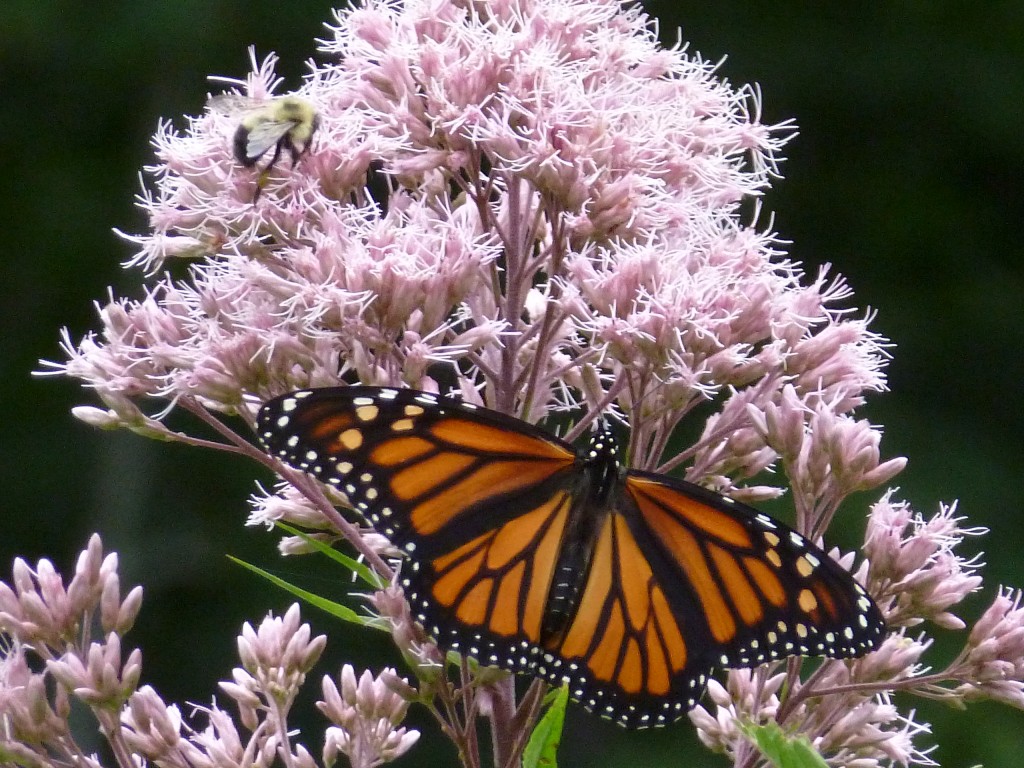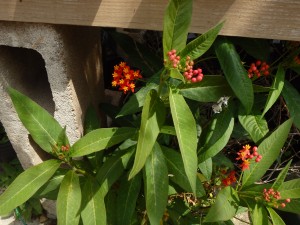
Nuwara Eliya A monarch butterfly on a Joe-Pye Weed, Eupatorium fistulosum, in my garden.
http://beccajcampbell.com/writing/6-ways-to-maximize-word-count-during-junowrimo One of the spectacular sights in my Catskill home the first fall I lived there was the monarch migration; I live in an old woodlot between two old farm fields, which have sprung up in goldenrod and spiraea, and that September thousands of monarchs would be in these fields at any one time. I expected similar shows in after years, but it never was quite the same. I planted milkweed (the lovely Asclepias tuberosa, which besides being beautiful is also perfectly deer-resistant) and was gratified to find monarch caterpillars on them; but that happened for only two years. They did not lay eggs on my plants in the last three years. Last year was the worst: not a single monarch showed up at all, caterpillar or adult.
This was not just an isolated incident, on Wildcat Mountain. Since 2008, my first season, the monarch population has declined by 85%; and since 1997, the decline has been 98%.
The monarch migration is the greatest migration in all the insect kingdom, and considering the frailty of the butterfly, is one of the great phenomena on earth. Riding on my bike on this trip I saw a monarch coming north along the river, and I was able to ride with him for a full fifteen minutes: he did not have any of that papilionic capriciousness, flitting from flower to flower, that we associate with the butterfly: he went steadily north at about eight or nine miles an hour, paralleling the bank of the river with singleminded purpose. The levee got close to a forest and I lost him in the woods, but I was amazed to see such continual applied activity in an insect, on so grand a scale. My journey thousands of miles up the river was considered by people unusual purpose and determination, armed as I was with a powerful animal body and mechanical strength. That little butterfly weighed perhaps an ounce, his body the plaything of every breeze, but his trip was similar. He himself would travel only several hundred miles before mating and dying; the next generation would go north again; it was only the last generation of summer which traverses the whole continent, flying all the way south in a single generation, as far as two thousand miles, to a single mountain ridge where the butterflies must stay densely packed in order to protect themselves from the cold, which even in Mexico would be sufficient to kill a solitary butterfly exposed to the wind. It was one of the amazing spectacles of life on earth.
No one has been able to pinpoint a single cause for the monarch’s decline because there probably is no one single cause: their lives are stretched thin as butterfly wings over an entire continent, and their existence depends on the ecological stability of all North America. They could be disrupted by logging in Mexico or herbicide-based farming in the Mississippi Valley or pesticide use in Northeastern suburbs or by an alteration in climate triggers which set off the migration. And since all those things are happening – a lot – it is not really a surprise that the monarch is dying off, and that a life-stream which has run for a million years or more may in a single generation dry itself out in the desert of man’s life-killing ingenuity.
Habitat loss and logging in Mexico has proven to be the easiest problem to solve, since the monarchs’ overwintering area is so small. Currently the predominant theory about the cause of monarch decline is a noticeably correspondent decline in the presence of the native host plant, any of several species of the North American genus Asclepias. These plants – milkweeds – due to a deep root system resistant to hoeing, were a staple agricultural weed. Superior weed-controlling technology, and in particular roundup-ready crops which allowed farmers to spray entire fields with glyphosphate, have very nearly eliminated the milkweed genus from farmland. Roundup-ready soybeans were approved by the FDA in 1994; the monarch butterfly decline began in 1997. As I have said, 98% of the population has vanished since then. Roundup-ready corn was approved in 1998.
But did this really make sense? Is there really enough farmland to make this kind of impact? All throughout New York State, there is farmland, and milkweeds may not be in the fields or at the fields’ edge anymore, but milkweed is still an abundant plant – there is much more milkweed than the monarchs can possibly use.
What I realized was that I had a unique opportunity of observing this problem: I would be traveling an entire monarch migration route, south to north, never exceeding a speed at which I could identify an Asclepias, for more than two thousand four hundred miles. If there were lots of Asclepias plants I would see them. And if there weren’t – well, what then?
That’s where I needed some help.
I had arrived at the garden center on Freret Street. There was a woman moving a tray of plants in the open lot that served as this neighborhood’s plant source. “Excuse me,” I said, “do you have any milkweed plants?”
“Sure. We potted up a few earlier in the year, I think they’re over by the fence over there.”
Looking over there, I saw one – that ended up being all she had. “I see you’ve got one coming up by the little shack over there too,” I said, pointing out a plant I had seen a bit earlier. It was in the ground. “It’s blooming already!”
“Do you want that one? I can dig it up for you.”
“No no, that’s fine, I’m just admiring how early things bloom around here. Do people ask for them?”
“We’ve definitely sold more than normal, you know with the monarchs and all.”
“So people are aware of this. That’s good.”
“Oh yeah. We have seeds inside, a woman here has been going around getting people to plant milkweeds. Let me show you.” And she showed me a little display by the cash register, of cute little boxes of milkweed seeds, put together by someone who called herself “the NOLA bug lady.”
“God bless that woman, I hope she peoples the world with her offspring,” I said.
“What?”
“Don’t worry, just something I say. These all say Asclepias curavassica. Do you have other species or is that it?”
“That’s all we have.”

Asclepias curavassica blooming in a crack in the pavement at the garden center. Pretty red flowers - a tropical milkweed. A great plant for the lower Mississippi.
“Let me pick up two boxes. I’m also going to take that plant out there. This is great. See, I’m biking up the Mississippi River. I’ve already passed a lot of waste ground that no one bothers with where milkweed would do very well. I can plant this stuff all the way up the river. I imagine this species won’t work all the way up, but I’ll be able to get seeds from other places, I bet. And the plant is for my host, the guy I’m staying with. He has a big garden, he can find a place for a milkweed. And keep telling other gardeners. Your asclepias in the ground over there is actually the first I’ve seen around here. And it’s a beautiful plant!”
“Oh yeah, it’s nice. And you know, people are talking about it.”
After paying, I said, “I’ll come back for the plant later, I don’t want to carry it around. But I’m so grateful you’ve got it, I hope you’ll get some more in stock!”
“Oh we definitely will, as I said, there’s people talking.”
Of course there were people talking down here. New Orleans has had its near-death experience, and now people are looking for causes – looking to do good even in their little gardens. I know someone who started a whole not-for-profit improving New Orleans gardens – largely with native plants – called “Growing Home.” This was the kind of thing that was happening all over the city, in so many little ways. As I have said before, living there was a statement – it was an act of faith, and it meant something. And people were tuned in to it.
I walked out of the shop with my two boxes of seeds. This was well started. That night I wrote to some people who I knew would be able to help me out by posting seeds to me as I rode north. I think it was just the next day that someone called me Johnny Milkweed Seed for the first time.
Post a Comment